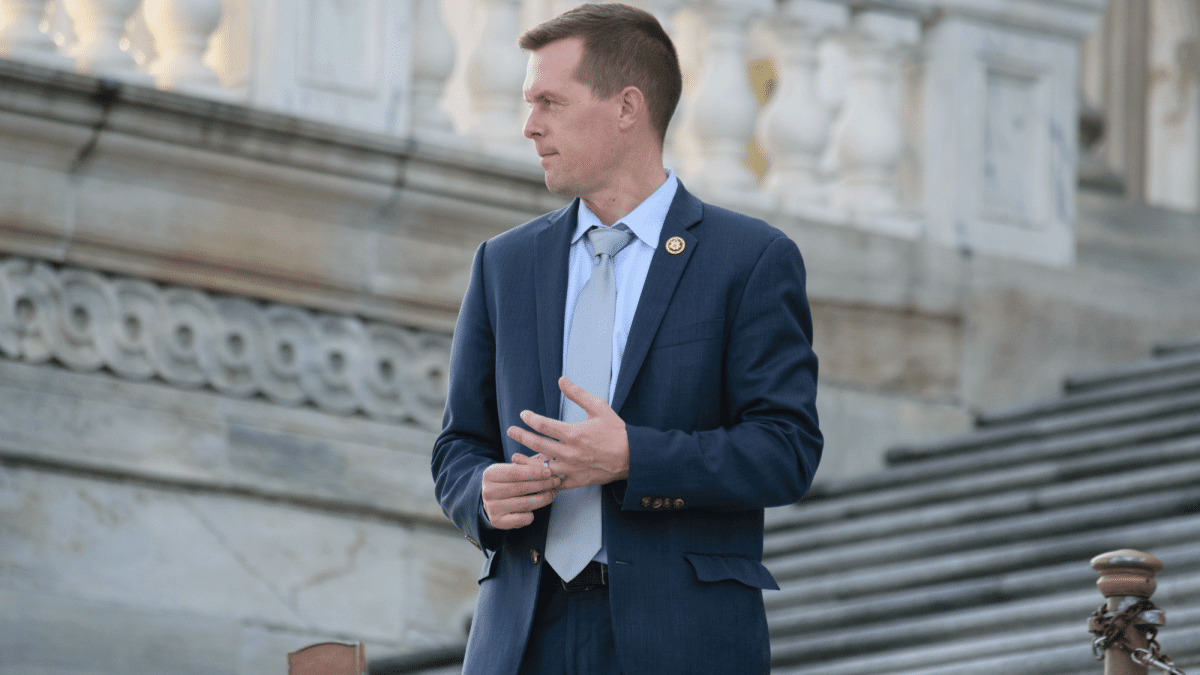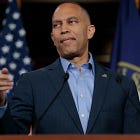Democrats push to restore union rights for federal workers
With bipartisan support and 222 cosponsors, Democrats are using a rare procedural move to try to force a vote on Rep. Jared Golden’s bill reversing Trump’s order targeting federal unions.

House Democrats launched an effort on Thursday to force a vote on a bill that would overturn an executive order President Donald Trump signed in March, which restricted collective bargaining rights for more than a million federal workers.
Rep. Jared Golden (D-Maine) and House Minority Leader Hakeem Jeffries (D-N.Y.) joined union leaders and pro-labor lawmakers to rally support for the Protect America’s Workforce Act. The bill, which has drawn 222 cosponsors—including seven Republicans—would nullify President Trump’s executive order and preserve union protections for federal employees.
With Speaker Mike Johnson declining to bring the measure to the floor, Democrats are turning to a discharge petition, a rarely used procedural tactic that would bypass leadership and force a vote if a majority of members sign on.
Golden told Once Upon a Hill that he hadn’t spoken with Johnson about bringing the bill to the floor, but that the speaker would have done so if it were a top legislative priority.
“I’m trying to be a humble guy. I don’t know that the speaker regularly meets with rank-and-file members, and particularly not those from the other side,” Golden said. “But I’m confident that some of the Republicans like Fitzpatrick definitely had those conversations.”
Golden added that Republicans told him the recently passed GOP reconciliation bill was too heavy a lift to focus on strengthening workplace protections.
“I get that, but [the reconciliation bill is] clear through the House, and now it’s a good time to focus on other important bipartisan work and things that we’re going to get done,” he said. “I feel pretty hopeful that they’ll get there.”
Jeffries framed the legislation as a test of whether Speaker Johnson would stand by his own words about letting the House work its will. He argued that the American Dream—decent wages, affordable housing, healthcare, education and a secure retirement—is made possible because of organized labor. Passing this bill, he said, would honor that legacy. And if Republican leadership allowed a floor vote, it would pass.
“We agree. And the House working its will means that this legislation that protects the right to organize, the freedom to organize and collective bargaining should be fully aired in a debate on the floor of the House of Representatives,” Jeffries said. “Given the unwillingness of Republican leadership to allow the House to work its will, there is another way.”
Trump’s executive order dramatically expanded the number of federal employees excluded from collective bargaining rights, further undermining the role of unions in the federal workforce. The order directs agencies to reclassify certain broadly defined national security-related positions, exempting them from the labor-management framework that governs most civilian federal workers.
While these exclusions have long existed under the law, the Trump administration is now interpreting them more aggressively, echoing efforts from his first term to weaken public-sector unions and strip worker protections. Golden’s bill aims to safeguard the rights of federal workers to organize and collectively bargain, pushing back on what Democrats view as a broad and politically motivated effort to weaken public-sector unions under the guise of national security.
Collective bargaining has been a cornerstone of American labor rights since the New Deal era, when the 1935 National Labor Relations Act guaranteed private-sector workers the right to organize and negotiate with employers over wages, hours, and working conditions. While federal employees were excluded from that law, presidents beginning with John F. Kennedy extended similar rights through executive orders, culminating in a robust labor-management framework that allowed most civilian federal workers to engage in collective bargaining.
Over the decades, these protections have been periodically tested, most notably during the Reagan administration’s firing of striking air traffic controllers and more recently during efforts by Republican administrations to limit the power of public-sector unions. The current debate marks a new flashpoint in the long-running struggle over the role of organized labor in the federal workforce.
A discharge petition is a procedural tool that allows a majority of the House—at least 218 members—to force a bill out of committee and onto the floor for a vote, bypassing leadership and committee chairs who may be blocking it. While rarely successful because rank-and-file members are often reluctant to defy party leadership or break ranks publicly, discharge petitions are usually used as a pressure tactic to spotlight stalled legislation and force members to take a public stand.


